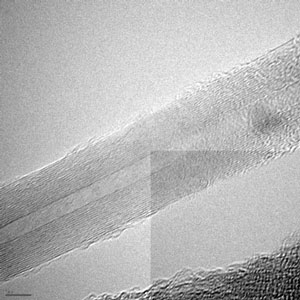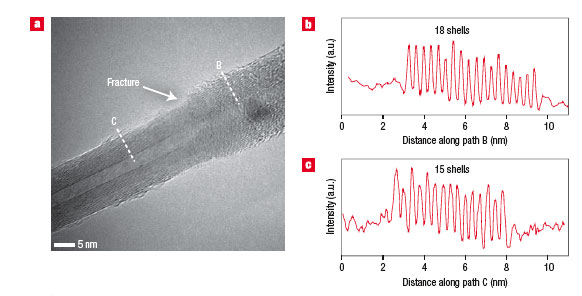| Posted: Aug 14, 2008 | |
Measured properties of carbon nanotubes match theoretical predictions |
|
| (Nanowerk Spotlight) Carbon nanotubes (CNTs) have been hyped as the wunderkind material of the 21st century. And while researchers have developed numerous CNT applications, ranging from nanoelectronics to nanomedicine and military armor, the actual properties of CNTs fell way short of what the theory predicted. The Wikipedia page for CNTs gives an overview of the various values of CNTs' mechanical properties and shows the discrepancy between theoretical prediction and experimental values. For instance, quantum mechanics calculations predict that defect-free single-walled carbon nanotubes possess a tensile strength of well over 100 gigapascals (GPa) – which translates into the ability to endure weight of over 10,000 kg on a cable with a cross-section of 1 square millimeter. In practice, CNT tensile strength of only up to 28 GPa have been measured. | |
| The problem lies not so much with the actual CNTs but rather with the mechanical tests that have been employed so far. It is very difficult to produce testable samples without damaging the tubes (which in turn adversely affects their properties), and to image the test with high enough resolution to determine the exact nature of the fracture. | |
 |
|
| TEM image of an unfractured multi-walled carbon nanotube (Image: Espinosa Group, Northwestern University) | |
| First experimental measurements of the mechanical properties of carbon nanotubes have now been made that directly correspond to the theoretical predictions. The researchers were able to overcome existing obstacles, conduct tests on nearly pristine nanotubes, and determine their geometry at failure such that our measurements are meaningful, reliable, and completely unambiguous. This allowed them to make the first meaningful comparisons between experimental tests and theoretical models. | |
| "Many of the previous studies in this field were computational," Dr. Horacio Espinosa explains to Nanowerk. "However, the computational nanotube models that have been used never really directly corresponded to any experiments. The nanotubes we tested, however, could be characterized well in terms of number of shells, diameter, chirality, etc. We were able to do a direct comparison of our experimental results with nanotube models that represented them accurately. This let us solve the problem of the validity of certain computational methods for these types of systems. We hope this will be useful for many researchers in the future." | |
| Espinosa, a professor in the Department of Mechanical Engineering at Northwestern, who collaborated with collaborated with Dr. George Schatz, a professor of Chemistry at the Weinberg College of Arts and Science, as well as with Dr. Peter Zapol, a scientist at Argonne National Laboratory, reported these findings in the August 10, 2008 online edition of Nature Nanotechnology ("Measurements of near-ultimate strength for multiwalled carbon nanotubes and irradiation-induced crosslinking improvements"). Together with first authors Bei Peng and Mark Locascio, PhD students in Espinosa's group, the scientists resolved a long-standing discrepancy between theory and experiment by providing the first direct measurements for tensile fracture strengths of multiwalled carbon nanotubes that are near the ultimate strength estimates of quantum mechanics calculations. | |
| "The most significant result that we achieved was experimental measurements that agree with quantum mechanics predictions" says Espinosa. "This includes Young’s modulus, failure stress, and failure strain of a single shell of a carbon nanotube. They came out to be about 1 TPa, 100 GPa, and 11%, respectively. These numbers come extremely close to theoretically predicted values, and our tests showed remarkable consistency. This consistency in our measurements is a first for researchers studying the mechanical properties of nanotubes." | |
| Additionally, the researchers tested the effect of irradiation on nanotubes. One would think that irradiation would degrade the atomic structure of the material, but the researchers found the opposite. It had been theorized by others that this should strengthen the tubes, but Espinosa's team showed a causal relationship between increased irradiation dose and increased load capacity. This is a very important result for others in the field because it provides a convenient way to tailor the properties of a tube as a function of the application. | |
 |
|
| Electron irradiation effects. a, TEM image of multiple-shell fracture for sample 4. b,c, Paths B (b) and C (c) were used to create intensity profiles on either side of the fracture to identify the number of failed shells (Reprinted with permission from Nature Publishing Group) | |
| Espinosa mentions that the idea of irradiation-strengthening has been around for a few years. "In order to really isolate and understand the mechanism at work, though, we needed first to have some baseline single-shell tests using the aforementioned capabilities. Using this method we could study irradiation in a way that gave trustworthy results. This was our motivation for all of our work. Our lab has developed the proper tools for this type of nanoscale testing in order to resolve experimental inconsistencies, which in turn will aid the design of nanodevices and nanomaterials for their mainstream introduction in the market." | |
| One of the primary goals of Espinosa's group is to develop a large-scale material composed of CNTs that shares their mechanical properties. Nanotubes are incredibly strong compared to traditional materials, but far too small to be useful in a lot of cases. Espinosa says that they would like to extend their work by investigating ways to bundle nanotubes together into large ropes and fibers that could be used for everyday building materials, body armor, sporting equipment, etc (for example, see our recent Spotlight: "To the cosmos by nanotechnology"). This work could give rise to entire classes of novel materials. | |
| Aside from these applications, there still appears to be plenty of work to be done with CNT characterization. The electrical and thermal properties are interesting as well, and open up new vistas for microelectronic devices. | |
| "There are still a number of problems associated with using nanoscale structures like nanotubes" says Espinosa. "Among them are problems like manipulation, dispersion, and uniformity of samples. In essence, these are all issues of control. Controlling objects only 10 nanometers wide is difficult and it has held back a lot of the potential applications. This is a very active field of research, though, and solutions to these problems are being pursued by many very talented scientists." | |
 By
Michael
Berger
– Michael is author of three books by the Royal Society of Chemistry:
Nano-Society: Pushing the Boundaries of Technology,
Nanotechnology: The Future is Tiny, and
Nanoengineering: The Skills and Tools Making Technology Invisible
Copyright ©
Nanowerk LLC
By
Michael
Berger
– Michael is author of three books by the Royal Society of Chemistry:
Nano-Society: Pushing the Boundaries of Technology,
Nanotechnology: The Future is Tiny, and
Nanoengineering: The Skills and Tools Making Technology Invisible
Copyright ©
Nanowerk LLC
|
Become a Spotlight guest author! Join our large and growing group of guest contributors. Have you just published a scientific paper or have other exciting developments to share with the nanotechnology community? Here is how to publish on nanowerk.com.
